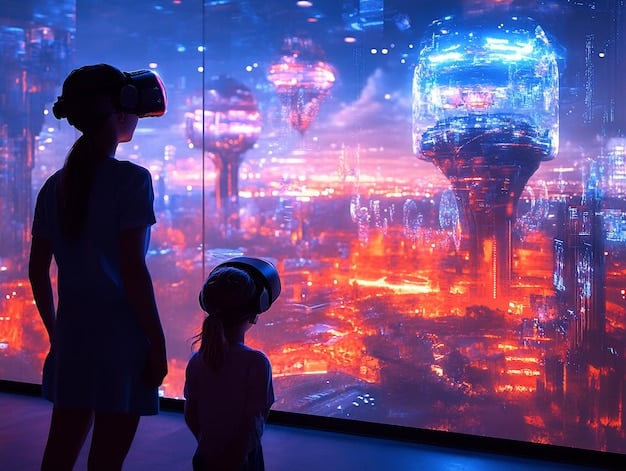The Future of K-Dramas: Trends & Innovations in 5 Years

The future of K-dramas is poised for significant evolution, incorporating technological innovation, diverse storytelling, and expanding global production partnerships, which will redefine how these captivating series are created and consumed over the next five years.
In a world rapidly embracing global content, the phenomenon of K-dramas has transcended cultural boundaries, captivating audiences worldwide with their unique blend of compelling narratives, exquisite production, and charismatic performances. What began as a niche interest has blossomed into a global entertainment powerhouse, leading many to ponder: what does The Future of K-Dramas: Predicting the Trends and Innovations We’ll See in the Next 5 Years truly hold? As a journalist immersed in media and cultural shifts, I’ve observed firsthand the dynamic forces shaping this industry, and the next half-decade promises to be nothing short of revolutionary.
The rise of immersive technologies in storytelling
The landscape of entertainment is constantly evolving, with technology playing a pivotal role in shaping how stories are told and consumed. K-dramas, known for their visual appeal and innovative narratives, are exceptionally well-positioned to embrace these technological advancements. Over the next five years, we anticipate a significant surge in the integration of immersive technologies, moving beyond traditional viewing experiences to offer audiences deeper engagement.
Virtual and augmented reality experiences
Imagine not just watching your favorite K-drama, but stepping into its world. While full-dive VR might still be a distant dream, more accessible forms of virtual reality (VR) and augmented reality (AR) are already making inroads. For K-dramas, this could translate into companion experiences that allow fans to explore set designs, interact with digital avatars of characters, or even participate in narrative extensions.
- Interactive story elements: Viewers might influence minor plot points or character choices through app-based interactions linked to live broadcasts or on-demand content.
- Enhanced pre-release content: VR tours of drama sets, AR filters on social media featuring drama-specific elements, and virtual meet-and-greets with cast members could become standard.
- Merchandise integration: AR could bring K-drama merchandise to life, offering exclusive content or interactive features when scanned.
These innovations aren’t just about novelty; they are about enhancing fan engagement and creating a more personal connection with the narratives. The industry is looking for ways to extend the drama experience beyond the screen, and immersive tech offers a compelling solution.
AI-driven content personalization
Artificial intelligence (AI) is already refining content recommendations, but its potential in K-dramas extends much further. Within five years, we could see AI playing a subtle yet significant role in personalizing content experiences. This isn’t about AI writing entire scripts, but rather informing subtle adaptations or suggesting alternative endings that align with viewer preferences, perhaps through interactive choices offered at pivotal plot points.
AI could also analyze viewer data to inform production decisions, identifying successful narrative structures, character archetypes, or thematic elements that resonate most deeply with specific demographics. This could lead to a more targeted approach in content creation, ensuring that dramas appeal to their intended global audiences without sacrificing creative integrity. The aim is to use data not to standardize, but to intelligently diversify and refine.
The convergence of advanced visual effects, enhanced sound design, and these new interactive layers promises a much richer and more personalized viewing experience. K-drama producers will likely invest heavily in these areas, not only to stay competitive but to continue pushing artistic boundaries.
Diversification of genres and themes
Historically, K-dramas have been celebrated for their mastery of romantic comedies, melodramas, and historical epics. While these genres will undoubtedly remain popular, the next five years are set to witness a significant diversification in the types of stories K-dramas tackle. This expansion is driven by a maturing audience, global demand for varied content, and a growing willingness within the industry to experiment.
Deepening into niche genres and social commentary
We’re already seeing a move towards more complex and thought-provoking narratives. Expect an acceleration in K-dramas exploring niche genres like dystopian sci-fi, dark psychological thrillers, and intricate legal or medical dramas that delve into ethical dilemmas. Beyond genre, K-dramas are increasingly becoming platforms for social commentary, addressing contemporary issues with nuance and depth.
- Socially conscious narratives: Dramas will continue to explore themes such as mental health awareness, class disparity, environmental concerns, and gender equality, challenging societal norms and sparking important conversations.
- Experimental storytelling: Expect more non-linear narratives, anthology series, and dramas that blend genres in unexpected ways, pushing the boundaries of traditional K-drama formats.
- Exploration of diverse lifestyles: Stories will increasingly reflect a broader spectrum of Korean society, including narratives from marginalized communities and alternative family structures.
This shift reflects a global audience that appreciates stories with substance, often preferring content that resonates with real-world issues rather than just escapism. The success of dramas like “Squid Game” and “Parasite” has shown the immense global appetite for Korean content that fearlessly examines societal flaws.

Expanded international collaborations
To support this genre diversification and reach wider audiences, collaboration with international production companies and streaming platforms will intensify. These partnerships bring not only financial resources but also diverse perspectives and access to global talent. While remaining authentically Korean, future K-dramas might incorporate non-Korean actors, writers, or directors for specific roles or creative input, enriching the storytelling.
This doesn’t mean a dilution of K-drama identity, but rather an evolution. Imagine a K-drama with a universally appealing plot filmed partly in, say, Europe or Latin America, or a series that incorporates elements of traditional Korean folklore with advanced Western cinematographic techniques. Such collaborations ensure that K-dramas remain fresh, innovative, and capable of tapping into new markets while maintaining their distinct charm. It’s about a strategic global dialogue that enriches the content and expands its appeal beyond the traditional Hallyu wave.
Production innovation and sustainability
As the demand for K-dramas soars, so does the need for more efficient, high-quality, and sustainable production practices. The next five years will see significant investments in production innovation, aiming to streamline processes, enhance visual quality, and address growing concerns about environmental impact.
Advanced filming techniques and virtual production
The visual quality of K-dramas is already world-class, but technological advancements will push this even further. Expect wider adoption of virtual production techniques, similar to those used in Hollywood blockbusters like “The Mandalorian.” This involves using LED walls to display digital environments in real-time, allowing actors to perform within intricate, high-definition virtual sets. This reduces the need for extensive location shooting, offering greater creative control, flexibility, and often cost savings in the long run.
- Real-time rendering: Virtual production allows for immediate visual feedback, streamlining the filming process and reducing post-production time for complex visual effects.
- Enhanced creative freedom: Directors can create fantastical or historically accurate environments with unprecedented detail and realism, unbound by physical location limitations.
- Reduced logistics: Less travel and fewer on-location permits translate to a more efficient and potentially more sustainable production pipeline.
We’ll also see continued refinement in camera technology, lighting, and sound design, all contributing to a more cinematic experience even on smaller screens. The emphasis will be on creating highly immersive visual and auditory landscapes that draw viewers deep into the story.
Sustainable production practices
With increasing global awareness about climate change, the entertainment industry is under pressure to adopt more sustainable practices. K-drama productions, as major undertakings, will likely respond by incorporating eco-friendly measures. This could involve reducing waste on sets, opting for renewable energy sources where possible, and minimizing travel through the use of virtual production and local sourcing.
The goal is to not only maintain the artistic integrity and high production values but to do so responsibly. This might also extend to narrative choices, with more K-dramas subtly weaving in themes of environmental stewardship or sustainable living, thereby influencing public perception through entertainment.
Investing in prop and costume recycling programs, utilizing energy-efficient equipment, and promoting sustainable catering options are small steps that cumulatively contribute to a larger environmental impact. As the global spotlight on K-dramas intensifies, so too does the expectation for them to lead by example in evolving industry standards.
The evolution of talent and fandom engagement
The K-drama industry wouldn’t be where it is without its exceptional talent pool – from writers and directors to actors and production crews. Over the next five years, we’ll see significant shifts in how talent is cultivated, recognized, and how fandoms engage with their beloved stars and series.
Emergence of new talent and global casting
As the industry expands, so does the demand for fresh faces and versatile actors capable of portraying diverse roles. Training programs for actors, writers, and directors will become more specialized, focusing not just on traditional skills but also on adapting to new technologies and diverse subject matters. We might see a more formalized system for identifying and nurturing talent from a younger age, preparing them for a global stage.
Furthermore, global casting will become more prevalent. While K-dramas will largely remain Korean-centric, the inclusion of non-Korean actors in supporting or even leading roles could become more common, particularly in internationally co-produced series. This reflects a broader trend towards diversity and inclusion in global entertainment, and it allows K-dramas to tell stories with a more universal appeal, reflecting the globalized world we live in.
The emphasis will be on talent that can not only deliver compelling performances but also connect with an international audience through various media platforms, including social media and live fan events. Bilingualism and cultural fluency might become increasingly valuable assets for emerging stars.

Advanced fan engagement platforms
K-drama fandoms are renowned for their passion and dedication. The industry will leverage technology to foster even deeper engagement. Beyond traditional fan meetings and social media interactions, expect dedicated, AI-powered fan platforms that offer personalized content, exclusive behind-the-scenes access, and opportunities for direct interaction with creators and cast.
- Subscription-based fan communities: Exclusive content such as unreleased scenes, bloopers, personalized messages, and online Q&A sessions with actors.
- Gamified fan experiences: Challenges, quizzes, and interactive polls related to dramas, with rewards like digital merchandise or early access to new content.
- Decentralized fan engagement: Exploring the use of NFTs (Non-Fungible Tokens) for unique fan collectibles or exclusive access perks, creating new avenues for monetization and community building.
This evolution will transform passive viewership into active participation, strengthening the bond between creators and their audience. The industry understands that engaged fans are loyal fans, and providing innovative ways for them to connect with content and talent is paramount for sustained success.
Strategic streaming and distribution models
The global reach of K-dramas has been significantly amplified by the proliferation of streaming services. In the next five years, the strategies around streaming and distribution will become even more sophisticated, focusing on market penetration, content exclusivity, and diverse revenue streams.
Hyper-localization and global market penetration
While global platforms like Netflix have been instrumental, K-dramas will increasingly target hyper-localized distribution. This means not just subtitles or dubbing, but content curation that considers specific regional tastes, cultural nuances, and broadcasting regulations. Partnerships with local streaming services and traditional broadcasters in different countries will become more strategic, ensuring content reaches audiences through their preferred channels.
Furthermore, expect to see content tailored for specific international markets. While the core K-drama identity will remain, certain themes or formats might be developed or adapted with a particular region in mind, increasing global market penetration beyond the current mainstream fan base. This intelligent approach to distribution ensures maximum reach and relevance.
The focus will be on understanding individual market demands and delivering content that aligns with local cultural landscapes, while simultaneously maintaining the global appeal that has made K-dramas so successful. This approach moves beyond a one-size-fits-all model to a more nuanced, region-specific strategy.
Innovative monetization and content exclusivity
The competition for premium content is fierce, and K-drama producers will leverage their growing influence to secure advantageous deals. This will involve more exclusive licensing agreements with major streaming platforms, creating highly anticipated “tentpole” K-drama releases that drive subscriptions.
- Tiered access and premium content: Offering early access to episodes, director’s cut versions, or special behind-the-scenes content through premium subscription tiers.
- Intellectual property (IP) expansion: Leveraging successful K-drama IPs across various media, including webtoons, web novels, games, and merchandise, creating comprehensive entertainment universes.
- Hybrid release models: Experimenting with simultaneous theatrical and streaming releases for high-budget dramas, catering to different viewer preferences and maximizing initial revenue.
Diversifying revenue streams beyond traditional subscription models will be crucial. This includes exploring advertising-supported tiers, pay-per-view options for special events, and robust merchandising strategies. The goal is to build a sustainable ecosystem around K-dramas that generates continuous value from its intellectual property and fan base, securing its long-term future in the global entertainment market.
The continuing influence of Hallyu
The “Hallyu” or Korean Wave, encompassing K-pop, K-dramas, film, and general Korean culture, isn’t just a fleeting trend; it’s a deeply embedded global phenomenon that continues to shape entertainment and cultural consumption. In the next five years, the influence of Hallyu will evolve, cementing K-dramas place as a leading cultural export.
Beyond entertainment: cultural exchange and soft power
K-dramas are more than just entertainment; they are powerful vehicles for cultural exchange. As their popularity grows, they will increasingly contribute to South Korea’s soft power, fostering greater understanding and appreciation of Korean language, customs, history, and societal values. This isn’t a deliberate governmental strategy as much as a natural byproduct of compelling storytelling.
We’ll see an uptick in language learning, tourism to Korea, and increased interest in Korean cuisine and fashion, directly attributable to the appeal of K-dramas. This cultural osmosis works both ways; as K-dramas gain global insights, they can subtly reflect that back, creating a richer, more internationally resonant narrative.
The narratives often showcase Korean resilience, innovation, and traditions, presenting a multifaceted view of the nation that goes beyond superficial representations. This deeper engagement fosters goodwill and strengthens diplomatic ties, making K-dramas a valuable cultural asset.
Challenges and adaptations in a globalized landscape
While the future is bright, the K-drama industry will also face challenges. Increased competition from other regional content powerhouses, the need to constantly innovate to avoid creative exhaustion, and navigating diverse global censorship and cultural sensitivities will require careful strategic planning. Maintaining authenticity while appealing to a global audience is a delicate balance.
Adaptability will be key. This includes quick responses to changing viewer preferences, embracing new technologies as they emerge, and continuously nurturing new generations of talent. The industry must avoid resting on its laurels, constantly striving for creative excellence and relevance.
Addressing potential over-saturation in certain genres, or the pressure to churn out content too quickly, will be crucial. Quality over quantity will remain a vital guiding principle for sustained global appeal. The journey of K-dramas is one of continuous evolution, propelled by creativity, innovation, and an unwavering connection with its rapidly expanding global audience.
| Key Trend | Brief Description |
|---|---|
| 💡 Immersive Tech | VR/AR experiences & AI personalization for deeper viewer engagement. |
| 🎭 Genre Diversification | More niche genres, social commentary, and international co-productions. |
| 🌿 Sustainable Production | Adoption of virtual production & eco-friendly practices. |
| 🌐 Global Distribution | Strategic streaming partnerships, hyper-localization, and new monetization. |
Frequently asked questions about the future of K-dramas
▼
While romance will likely remain a strong element, the K-drama industry is diversifying significantly. Expect an increase in dramas spanning various genres such as sci-fi, thrillers, historical fantasy, and social commentary, reflecting a broader range of storytelling and appealing to a wider global audience beyond traditional romantic themes.
▼
Technology will transform K-drama production. Virtual production using LED walls will become more common, offering realistic digital sets and reducing location shoots. AI might assist in content personalization and data-driven insights, while improved visual effects and sound design will enhance overall cinematic quality, creating more immersive viewing experiences.
▼
International collaborations are set to increase, bringing diverse perspectives and resources. While this may introduce new artistic influences, the core “Korean style” – characterized by its emotional depth, strong narratives, and aesthetic quality – is expected to remain intact. Collaborations will aim to enrich, rather than dilute, the distinct K-drama identity, fostering wider global appeal.
▼
Fan engagement will evolve beyond current social media interactions. Dedicated, technologically advanced fan platforms will emerge, offering personalized content, exclusive behind-the-scenes access, and opportunities for direct interaction with cast and crew. Expect more interactive viewing options, gamified experiences, and exploring new digital assets like NFTs for unique fan collectibles.
▼
K-dramas will strategically balance universal themes with their inherent Korean cultural richness. While they’ll increasingly tackle global social issues and appeal to a broader international audience, the narratives will continue to be rooted in Korean perspectives, cultural nuances, and artistic sensibilities. This blend allows them to resonate globally while maintaining their authentic charm.
The continuous evolution of a cultural phenomenon
The journey of K-dramas over the past few decades has been nothing short of extraordinary, transforming from a regional curiosity into a global cultural phenomenon. As we look towards the next five years, it’s clear that this trajectory of innovation and expansion is far from over. From pushing the boundaries of technology to diversifying storytelling and fostering deeper global connections, K-dramas are poised to redefine what television content can achieve. They will continue to be a testament to the power of compelling narratives, exceptional talent, and a visionary industry committed to captivating hearts and minds across the world. The future a bright, dynamic, and endlessly fascinating one for K-dramas, solidifying their place as a leading force in global entertainment.





